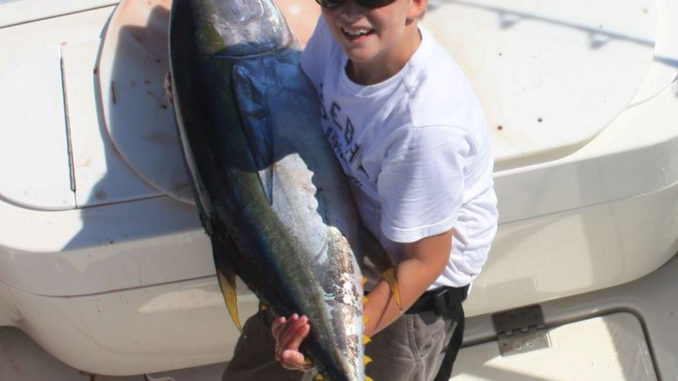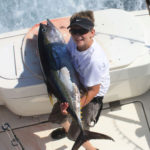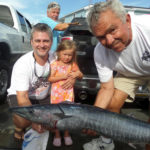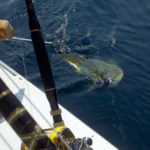
The village of Hatteras is the jumping-off spot for great bluewater fishing that cranks up in April.
The first bluewater fish to arrive off the Outer Banks each year are tuna, and their names include a small variety of colors. Bluefin have become regular visitors in March, staying until the water begins warming in April. Pods of blackfin pass through in winter, but the schools get larger and hungrier as spring arrives. They are joined by a few yellowfin and occasional bigeye tuna in late March and early April, and the fishing continues to improve.
The final players in the gamefish mix are wahoo and dolphin. A few strays are caught all winter, but as current edges and temperature breaks become better defined, their numbers grow. The exact timing and mix of the species varies, but April is typically the beginning of good fishing off Cape Hatteras, and it includes a mixture of species.
Rom Whitaker, a Kinston native, has more than three decades of experience as a Hatteras charter captain, and his Release is one of the most highly regarded boats in the Hatteras fleet.
“April is when our fishing usually begins to pick up,” Whitaker said. “The intensity of the winter and the transition into spring are the determining factors on exactly when things get going, but it is usually somewhere between the middle of March and middle of April.
“We have a few fish at the edge of the Gulf Stream all winter, but suddenly you notice the numbers are growing. I’ve been running a boat in Mexico for the past several winters, but I always plan to be back in Hatteras by the end of March to get ready for spring fishing.”
Whitaker said tuna handle cooler water better than many of the other pelagics, and their numbers begin growing first. Bluefins are the first to break the winter doldrums, followed by blackfins, yellowfins and an occasional bigeye. Dolphin used to arrive around the third week of April, but in recent years, they have begun arriving earlier. Their numbers increase towards the end of April and some of the largest dolphin arrive then.
A key to catching spring fish is to monitor the movement of the Gulf Stream and eddies it spins off. Satellite services are available that monitor sea surface temperatures, Gulf Stream movement and other factors that affect fish, and he checks several daily. But Whitaker said the best information is knowing where fish were caught the previous day and Hatteras fishermen are good about sharing information.
“Much of our spring fishing is around the rocks southeast of the (Diamond Shoals) tower,” Whitaker said. “Sometimes we head farther north or south, but you can usually find the conditions you want running to the southeast. There will be other boats fishing within radio range, so you can talk and know what’s happening over a larger area.
“Once in the area, I’m looking for something that shows an edge,” Whitaker said. “It could be a color change, an upwelling, a temperature break, a rip or maybe a weed or trash line. There are things that show the edges where currents or temperatures change, and that’s what I’m looking for.
“Most of the time, the fish are along the edges, but occasionally, they might be off of them a half-mile or more. Even while fishing along an edge, I’m always looking around for signs of fish. Sometimes it’s fish breaking, and sometimes it’s birds, but occasionally you move off the edge and concentrate on something else.”
Because of the variety of fish that might be caught, Whitaker begins each day with a spread using a little bit of everything, including sea witches with strips and ballyhoo, plastics with ballyhoo, a bird rig, a planer rig with a spoon or sea witch, cedar plugs and maybe a feather.
Once the fish start biting, he switches to the lures and baits producing bites that day. If dolphin are biting, he adds feathers; if it’s tuna, he gets more lures with ballyhoo in the spread. When wahoo are biting hard, he switches to darker lures rigged on wire leaders to hold up to their sharp teeth.
“Jigging has become popular, and a growing number of fishermen are asking to do it,” Whitaker said. “Blackfin tuna are the primary jigging catch off Hatteras, and it can be red hot. Some days we begin jigging, and some days we troll and look for a good mark. You’ve got to be versatile to catch a variety of fish and keep the clients happy. We carry 47 rods and reels on the Release to do whatever it takes to catch fish on any day.”
Whitaker said one factor many fishermen don’t consider is current. It obviously affects bottom-fishing, but it also affects trolling. Faster currents hold fish deeper, especially tuna, and you have to get lures down to them. On light-current days, they usually feed closer to the surface, and those are the days everyone is looking for.
There isn’t a shortcut for getting to Hatteras, but the excellent spring offshore fishing is well worth the trip. Fish reach these waters from the south riding the Gulf Stream and from the north riding the Labrador Current. The two converging oceanic currents vary the fishing from day to day, but that’s not a bad thing, as they are the migratory highways that bring such a diversity of fish to the waters.
DESTINATION INFORMATION
HOW TO GET THERE — Hatteras is at the southern end of the Outer Banks on NC 12. You can get there by taking US 64 or US 264 east to Manteo and Nags Head, then turning south, or by taking US 158 east to the Kill Devil Hills area and taking NC 12 south. An alternate route is to go through Morehead City to Cedar Island and take ferries to Ocracoke and Hatteras, or take US 264 to Swan Quarter and take ferries to Ocracoke and Hatteras.
WHEN TO GO — Hatteras gets bluefin tuna in February and March, but the main charter season begins in late March and early April as the wahoo, dolphin, yellowfin and blackfin tuna making appearances. An occasional billfish will show up as the water begins to warm.
BEST TECHNIQUES — Standard tackle for offshore trolling is 30- to 50-pound class, with 50-pound getting the nod around Hatteras because of the size of the fish often encountered. Stand-up rods are popular, especially on small boats that don’t have fighting chairs. A combination of 50- to 100-pound braid, a monofilament top shot of 100 to 150 yards of 100-pound test is standard rigging. Most fishermen troll medium ballyhoo rigged into sea witches, hair lures and cedar plugs or high-speed lures.Mono or fluorocarbon leaders are preferred, but the sharp teeth of wahoo require wire.
FISHING INFO/GUIDES — Capt. Rom Whittaker, Release Sportfishing, 252-986-1031, www.hatterasrelease.com; Hatteras Harbor Marina (www.hatterasharbor.com, 252-986-2166); Teach’s Lair Marina (www.teachslair.com, 252-986-2460); Hatteras Landing Marina (www.hatteraslanding.com, 252-986-2077); Oden’s Dock (www.breakwaterhatteras.com, 252-986-2555). See also Guides and Charters in Classifieds.
ACCOMMODATIONS — The Breakwater Inn, Hatteras, 877-986-2565, www.breakwaterhatteras.com; Outer Banks Chamber of Commerce, 800-627-3150, www.outerbankschamber.com.
MAPS — Capt. Segull’s Nautical Charts, 888-473-4855, www.captainsegullcharts.com; Sealake Fishing Guides 800-411-0185, www.thegoodspots.com; Maps Unique, 910-458-9923, www.mapsunique.com; Grease Chart, 800-326-3567, www.greasechart.com.






Be the first to comment